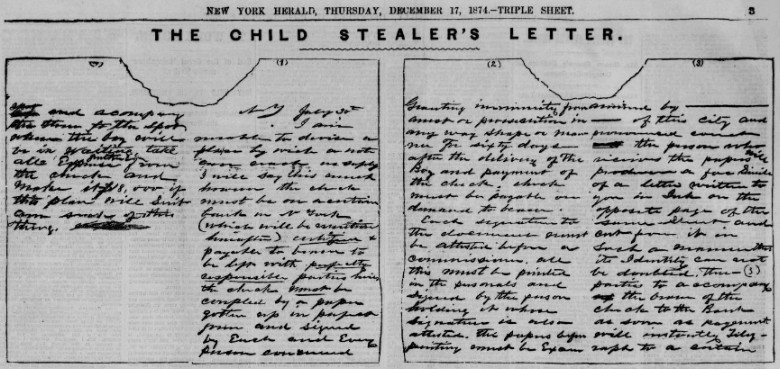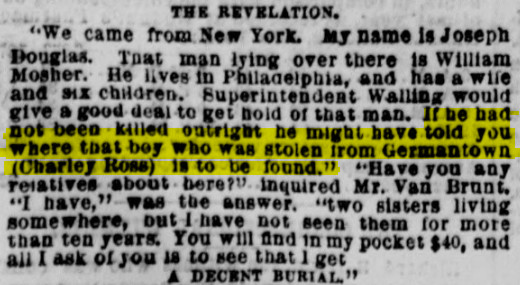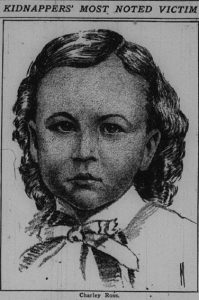Today we bring you a harrowing true-crime story from Heather Thomas, a reference librarian in the Serial and Government Publications Division. She posted this on the division’s website recently, and we wanted to make sure you saw it. It’s one of those stories that lingers in the mind — particularly for parents.
“KIDNAPPERS MOST NOTED VICTIM,” New York Times, June 29, 1947, p. XX4
Don’t take candy from strangers.
Little Charley Ross, the first missing child to make national headlines, made that mistake. The Gilded Age kidnapping became the forerunner of sensational child abductions that transfixed the nation, much as the kidnapping of the Lindbergh baby did half a century later. To the current generation, Charley Ross was the Adam Walsh or the JonBenét Ramsey of his day.
It started in the summer of 1874, when two men in a horse-drawn buggy pulled into an affluent neighborhood in Philadelphia. They befriended two little boys who were playing in front of their stately home, in part by giving them candy. For five days in a row, four-year-old Charley Ross and his six-year-old brother Walter chatted with the pair.
On July 1, 1874, the men pulled up as usual, but this time they offered to take the boys to buy candy and fireworks for the upcoming Independence Day holiday, and the boys agreed. After driving a ways, the men sent Walter into a shop to buy fireworks, while they stayed with Charley in the buggy. When Walter came out of the store, the buggy was gone.
Several days later, the boys’ father, Christian Ross, received the first of 23 ransom letters from the kidnappers demanding $20,000 for Charley’s release. It was a miscalculation. Ross’s fortunes had been greatly diminished by the stock market crash of 1873. He could not afford the ransom. He went to the police.

“THE CHILD STEALER’S LETTER,” The New York Herald, December 17, 1874
Detectives searched tirelessly for Charley. They got nowhere. Ross used the the personal column in the Public Ledger to try to communicate with the blackmailers, but to no avail. Theories about the kidnapping circulated. Still, there was no sign of Charley.
Some three months later, in December, police shot Joseph Douglas and William Mosher during a botched burglary in Brooklyn, NY. Mosher was killed instantly. But as Douglas lay dying, he confessed that the pair had kidnapped Charley. He told police that Mosher — now dead — had been the only person who knew where Charley was being held. Two hours later, he was dead.

“THE REVELATION,” The New York Herald, December 15, 1874
Police later arrested a Mosher’s brother-in-law, William Westervelt, a disgraced Philadelphia policeman, and charged him with being part of the kidnapping. While awaiting trial, Westervelt told Ross that Charley had been alive at the time Mosher was killed. Westervelt beat the kidnapping charges in court, but the jury convicted him of conspiracy. He was sentenced to six years in prison.
Ross, meanwhile, kept searching. He wrote a book, The Father’s Story of Charley Ross, the Kidnapped Child, and poured all the profits from the book into the search. Thousands of circulars about the abduction and pictures of Charley were posted in police stations, railroad stations, post offices, and ship ports across the nation. Over several decades, the Ross family spent more than $60,000 looking for Charley, which included following leads and investigating more than a thousand imposters claiming to be the missing child.

Court Identifies ‘Charley Ross’ But Family ‘Disowns’ Him,” The Evening Star (Washington, DC), May 9, 1939, p. 5
One of the last and most enduring claims was that of Gustave Blair, a carpenter. In 1939, an Arizona court ruled that he was Charley Ross after he told a jury that he vaguely remembered being held prisoner in a cave as a small boy and that the family who had raised him told him that he was a kidnap victim. After the ruling, he officially changed his name to “Charley Ross” and travelled to Pennsylvania, but the Ross family refused to accept him.
And there it ends. The kidnapping of little Charley Ross was one of the most sensational crimes of the late 19th century, yet what really happened to him remains a mystery.
Subscribe to the blog— it’s free! — and the largest library in world history will send one cool story to your inbox Monday-Friday.

“KIDNAPPERS MOST NOTED VICTIM,” New York Times, June 29, 1947, p. XX4
Don’t take candy from strangers.
Little Charley Ross, the first missing child to make national headlines, made that mistake. The Gilded Age kidnapping became the forerunner of sensational child abductions that transfixed the nation, much as the kidnapping of the Lindbergh baby did half a century later. To the current generation, Charley Ross was the Adam Walsh or the JonBenét Ramsey of his day.
It started in the summer of 1874, when two men in a horse-drawn buggy pulled into an affluent neighborhood in Philadelphia. They befriended two little boys who were playing in front of their stately home, in part by giving them candy. For five days in a row, four-year-old Charley Ross and his six-year-old brother Walter chatted with the pair.
On July 1, 1874, the men pulled up as usual, but this time they offered to take the boys to buy candy and fireworks for the upcoming Independence Day holiday, and the boys agreed. After driving a ways, the men sent Walter into a shop to buy fireworks, while they stayed with Charley in the buggy. When Walter came out of the store, the buggy was gone.
Several days later, the boys’ father, Christian Ross, received the first of 23 ransom letters from the kidnappers demanding $20,000 for Charley’s release. It was a miscalculation. Ross’s fortunes had been greatly diminished by the stock market crash of 1873. He could not afford the ransom. He went to the police.

“THE CHILD STEALER’S LETTER,” The New York Herald, December 17, 1874
Detectives searched tirelessly for Charley. They got nowhere. Ross used the the personal column in the Public Ledger to try to communicate with the blackmailers, but to no avail. Theories about the kidnapping circulated. Still, there was no sign of Charley.
Some three months later, in December, police shot Joseph Douglas and William Mosher during a botched burglary in Brooklyn, NY. Mosher was killed instantly. But as Douglas lay dying, he confessed that the pair had kidnapped Charley. He told police that Mosher — now dead — had been the only person who knew where Charley was being held. Two hours later, he was dead.

“THE REVELATION,” The New York Herald, December 15, 1874
Police later arrested a Mosher’s brother-in-law, William Westervelt, a disgraced Philadelphia policeman, and charged him with being part of the kidnapping. While awaiting trial, Westervelt told Ross that Charley had been alive at the time Mosher was killed. Westervelt beat the kidnapping charges in court, but the jury convicted him of conspiracy. He was sentenced to six years in prison.
Ross, meanwhile, kept searching. He wrote a book, The Father’s Story of Charley Ross, the Kidnapped Child, and poured all the profits from the book into the search. Thousands of circulars about the abduction and pictures of Charley were posted in police stations, railroad stations, post offices, and ship ports across the nation. Over several decades, the Ross family spent more than $60,000 looking for Charley, which included following leads and investigating more than a thousand imposters claiming to be the missing child.

Court Identifies ‘Charley Ross’ But Family ‘Disowns’ Him,” The Evening Star (Washington, DC), May 9, 1939, p. 5
One of the last and most enduring claims was that of Gustave Blair, a carpenter. In 1939, an Arizona court ruled that he was Charley Ross after he told a jury that he vaguely remembered being held prisoner in a cave as a small boy and that the family who had raised him told him that he was a kidnap victim. After the ruling, he officially changed his name to “Charley Ross” and travelled to Pennsylvania, but the Ross family refused to accept him.
And there it ends. The kidnapping of little Charley Ross was one of the most sensational crimes of the late 19th century, yet what really happened to him remains a mystery.















